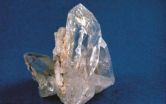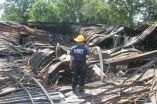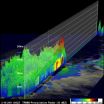(Press-News.org) More than 40 years ago, pioneering tectonic geophysicist J. Tuzo Wilson published a paper in the journal Nature describing how ocean basins opened and closed along North America's eastern seaboard.
His observations, dubbed "The Wilson Tectonic Cycle," suggested the process occurred many times during Earth's long history, most recently causing the giant supercontinent Pangaea to split into today's seven continents.
Wilson's ideas were central to the so-called Plate Tectonic Revolution, the foundation of contemporary theories for processes underlying mountain-building and earthquakes.
Since his 1967 paper, additional studies have confirmed that large-scale deformation of continents repeatedly occurs in some regions but not others, though the reasons why remain poorly understood.
Now, new findings by Utah State University geophysicist Tony Lowry and colleague Marta Pérez-Gussinyé of Royal Holloway, University of London, shed surprising light on these restless rock cycles.
"It all begins with quartz," says Lowry, who published results of the team's recent study in the March 17 issue of Nature.
The scientists describe a new approach to measuring properties of the deep crust.
It reveals quartz's key role in initiating the churning chain of events that cause Earth's surface to crack, wrinkle, fold and stretch into mountains, plains and valleys.
"If you've ever traveled westward from the Midwest's Great Plains toward the Rocky Mountains, you may have wondered why the flat plains suddenly rise into steep peaks at a particular spot," Lowry says.
"It turns out that the crust beneath the plains has almost no quartz in it, whereas the Rockies are very quartz-rich."
He thinks that those belts of quartz could be the catalyst that sets the mountain-building rock cycle in motion.
"Earthquakes, mountain-building and other expressions of continental tectonics depend on how rocks flow in response to stress," says Lowry.
"We know that tectonics is a response to the effects of gravity, but we know less about rock flow properties and how they change from one location to another."
Wilson's theories provide an important clue, Lowry says, as scientists have long observed that mountain belts and rift zones have formed again and again at the same locations over long periods of time.
But why?
"Over the last few decades, we've learned that high temperatures, water and abundant quartz are all critical factors in making rocks flow more easily," Lowry says. "Until now, we haven't had the tools to measure these factors and answer long-standing questions."
Since 2002, the National Science Foundation (NSF)-funded Earthscope Transportable Array of seismic stations across the western United States has provided remote sensing data about the continent's rock properties.
"We've combined Earthscope data with other geophysical measurements of gravity and surface heat flow in an entirely new way, one that allows us to separate the effects of temperature, water and quartz in the crust," Lowry says.
Earthscope measurements enabled the team to estimate the thickness, along with the seismic velocity ratio, of continental crust in the American West.
"This intriguing study provides new insights into the processes driving large-scale continental deformation and dynamics," says Greg Anderson, NSF program director for EarthScope. "These are key to understanding the assembly and evolution of continents."
Seismic velocity describes how quickly sound waves and shear waves travel through rock, offering clues to its temperature and composition.
"Seismic velocities are sensitive to both temperature and rock type," Lowry says.
"But if the velocities are combined as a ratio, the temperature dependence drops out. We found that the velocity ratio was especially sensitive to quartz abundance."
Even after separating out the effects of temperature, the scientists found that a low seismic velocity ratio, indicating weak, quartz-rich crust, systematically occurred in the same place as high lower-crustal temperatures modeled independently from surface heat flow.
"That was a surprise," he says. "We think this indicates a feedback cycle, where quartz starts the ball rolling."
If temperature and water are the same, Lowry says, rock flow will focus where the quartz is located because that's the only weak link.
Once the flow starts, the movement of rock carries heat with it and that efficient movement of heat raises temperature, resulting in weakening of crust.
"Rock, when it warms up, is forced to release water that's otherwise chemically bound in crystals," he says.
Water further weakens the crust, which increasingly focuses the deformation in a specific area.
INFORMATION:
Viscous cycle: Quartz is key to plate tectonics
Findings offer new approach to understanding movements of continents
2011-03-18
ELSE PRESS RELEASES FROM THIS DATE:
NIST releases final report on Charleston sofa store fire
2011-03-18
The National Institute of Standards and Technology (NIST) has released its final report on its study of the June 18, 2007, fire at the Sofa Super Store in Charleston, S.C., that trapped and killed nine firefighters, the highest number of firefighter deaths in a single event since 9/11. The final report is strengthened by clarifications and supplemental text based on comments provided by organizations and individuals in response to the draft report of the study, released for public comment on Oct. 28, 2010.
The revisions did not alter the study team's main finding: the ...
Pig model of cystic fibrosis improves understanding of disease
2011-03-18
It's been more than 20 years since scientists first discovered the gene that causes cystic fibrosis (CF), yet questions about how the mutated gene causes disease remain unanswered.
Using a newly created pig model that genetically replicates the most common form of cystic fibrosis, University of Iowa researchers have now shown that the CF protein is "misprocessed" in the pigs and does not end up in the correct cellular location. This glitch leads to disease symptoms, including gastrointestinal abnormalities and lung disease in the pigs, which mimic CF in humans. The findings ...
Online messaging delivers follow-up care for depression
2011-03-18
SEATTLE—Online messaging can deliver organized follow-up care for depression effectively and efficiently, according to a randomized controlled trial of 208 Group Health patients that the Journal of General Internal Medicine e-published in advance of print.
After five months, compared to the half of the patients randomly assigned to receive usual care, the half who had three online care management contacts with a trained psychiatric nurse were significantly more likely to feel less depressed, take their antidepressant medication as prescribed, and be "very satisfied" ...
Book Marketing: 3 Ways To Tell If You Have a Good Book Promotion Strategy by Annie Jennings PR
2011-03-18
By national publicity expert, Annie Jennings, of the famous PR firm, Annie Jennings PR
Authors are flocking to print on demand publishing and other non-traditional methods of publishing their book. With this growth of authors hitting the scene, so do a myriad of ways to promote a book. With so many choices available to them, how do author choose the right book marketing and book promotion strategy for them.
National publicity expert, Annie Jennings PR, whose national PR firm has worked with thousands of book authors, shares 3 ways to tell if you like your book marketing ...
WHOI-led report links sonar to whale strandings
2011-03-18
Scientists have long been aware of a link between naval sonar exercises and unusual mass strandings of beaked whales. Evidence of such a link triggered a series of lawsuits in which environmental groups sued the U.S. Navy to limit sonar exercises to reduce risk to whales. In 2008, this conflict rose to the level of the US Supreme Court which had to balance potential threat to whales from sonar against the military risk posed by naval forces inadequately trained to use sonar to detect enemy submarines. The court ruled that the Navy could continue training, but that it was ...
2 new SCAP documents help improve automating computer security management
2011-03-18
It's increasingly difficult to keep up with all the vulnerabilities present in today's highly complex operating systems and applications. Attackers constantly search for and exploit these vulnerabilities to commit identity fraud, intellectual property theft and other attacks. The National Institute of Standards and Technology (NIST) has released two updated publications that help organizations to find and manage vulnerabilities more effectively, by standardizing the way vulnerabilities are identified, prioritized and reported.
Computer security departments work behind ...
LateRooms.com - Head to Naples for The Aesthetics of Mould
2011-03-18
The Aesthetics of Mould is a new art exhibition in Naples that examines the creative process and compares it to the way nature evolves.
Running from March 25th to April 30th 2011, it will see the work of the production duo Ttozoi displayed at the Piazza S Eframo Vecchio.
The strange and captivating images created by the artists are very modern in their approach, but lean heavily on movements such as Gutai and abstract expressionism.
According to the organisers, the art on show is a perfect example of how a piece is born when the creator finishes painting it, but ...
NASA satellites show towering thunderstorms in rare sub-tropical storm Arani
2011-03-18
NASA's Aqua and TRMM satellites are providing data to scientists about the Southern Atlantic Ocean Sub-tropical Storm Arani, a rare occurrence in the southern ocean. Rainfall data and cloud top temperatures revealed some heavy rain and strong thunderstorms exist in Arani as it continues to pull away from Brazil.
NOAA's Satellite and Information Service classified Arani as a T1 on the Dvorak intensity scale which would indicate an estimated wind speed of about 29 knots (~33 mph).
During the daytime on Tuesday, March 15 at 1820 UTC (2:20 p.m. EST) NASA's Tropical Rainfall ...
Physicists move closer to efficient single-photon sources
2011-03-18
Washington, D.C. (March 16, 2011) -- A team of physicists in the United Kingdom has taken a giant step toward realizing efficient single-photon sources, which are expected to enable much-coveted completely secure optical communications, also known as "quantum cryptography." The team presents its findings in Applied Physics Letters, a journal published by the American Institute of Physics.
Fluorescent "defect centers" in diamond act like atomic-scale light sources and are trapped in a transparent material that's large enough to be picked up manually. They don't need to ...
'Pruned' microchips are faster, smaller, more energy-efficient
2011-03-18
GRENOBLE, France -- (March 16, 2011) -- An international team of computing experts from the United States, Switzerland and Singapore has created a breakthrough technique for doubling the efficiency of computer chips simply by trimming away the portions that are rarely used.
"I believe this is the first time someone has taken an integrated circuit and said, 'Let's get rid of the part that we don't need,'" said principal investigator Krishna Palem, the Ken and Audrey Kennedy Professor of Computing at Rice University in Houston, who holds a joint appointment at Nanyang Technological ...
LAST 30 PRESS RELEASES:
Heart-brain connection: international study reveals the role of the vagus nerve in keeping the heart young
Researchers identify Rb1 as a predictive biomarker for a new therapeutic strategy in some breast cancers
Survey reveals ethical gaps slowing AI adoption in pediatric surgery
Stimulant ADHD medications work differently than thought
AI overestimates how smart people are, according to HSE economists
HSE researchers create genome-wide map of quadruplexes
Scientists boost cell "powerhouses" to burn more calories
Automatic label checking: The missing step in making reliable medical AI
Low daily alcohol intake linked to 50% heightened mouth cancer risk in India
American Meteorological Society announces Rick Spinrad as 2026 President-Elect
Biomass-based carbon capture spotlighted in newly released global climate webinar recording
Illuminating invisible nano pollutants: advanced bioimaging tracks the full journey of emerging nanoscale contaminants in living systems
How does age affect recovery from spinal cord injury?
Novel AI tool offers prognosis for patients with head and neck cancer
Fathers’ microplastic exposure tied to their children’s metabolic problems
Research validates laboratory model for studying high-grade serous ovarian cancer
SIR 2026 delivers transformative breakthroughs in minimally invasive medicine to improve patient care
Stem Cell Reports most downloaded papers of 2025 highlight the breadth and impact of stem cell research
Oxford-led study estimates NHS spends around 3% of its primary and secondary care budget on the health impacts of heat and cold in England
A researcher’s long quest leads to a smart composite breakthrough
Urban wild bees act as “microbial sensors” of city health.
New study finds where you live affects recovery after a hip fracture
Forecasting the impact of fully automated vehicle adoption on US road traffic injuries
Alcohol-related hospitalizations from 2016 to 2022
Semaglutide and hospitalizations in patients with obesity and established cardiovascular disease
Researchers ‘listen in’ to embryo-mother interactions during implantation using a culture system replicating the womb lining
How changing your diet could help save the world
How to make AI truly scalable and reliable for real-time traffic assignment?
Beyond fragmented markets: A new framework for efficient and stable ride-pooling
Can shape priors make road perception more reliable for autonomous driving?
[Press-News.org] Viscous cycle: Quartz is key to plate tectonicsFindings offer new approach to understanding movements of continents




